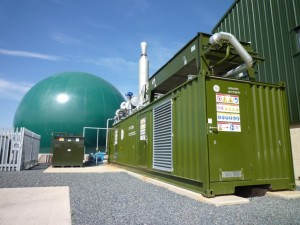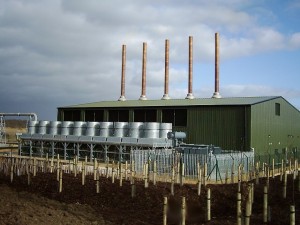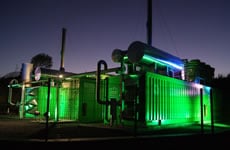 An integral part of the majority of anaerobic digestion facilities across the world is the CHP combined heat and power (CHP) engine. For the first time builder of a biogas plant, it is often neglected as the focus is on reducing the capital costs of the installation. However, the engine is integral to the plant, and is the key component in the production of renewable electricity, hence the realisation of revenues for the plant.
An integral part of the majority of anaerobic digestion facilities across the world is the CHP combined heat and power (CHP) engine. For the first time builder of a biogas plant, it is often neglected as the focus is on reducing the capital costs of the installation. However, the engine is integral to the plant, and is the key component in the production of renewable electricity, hence the realisation of revenues for the plant.
There are a number of technical factors that must be considered when selecting a biogas engine including:
- What is the volume and methane % of the biogas?
- What is the electrical and thermal efficiency of the engine?
- What availability can be expected from the generator?
- What technical support can I expect to receive after I have purchased my power plant?
What is the volume and methane % of the biogas that is available?
An engine works by burning gas in its cylinders. Combustion releases the energy in the gas which is converted into heat and mechanical force to drive the engine’s crank shaft. The crank shaft in turn rotates an alternator to produce electricity. The energy required to produce this mechanical force is consistent. The main components of biogas are methane, that contains energy and carbon dioxide that does not release energy when burnt in a gas engine. Therefore as the methane concentration lowers, a greater volume of gas is required to deliver the same energy content to the cogeneration plant.
As a rule of thumb, 1m3 of pure methane contains ~9.9kWh of energy.
Biogas varies in methane concentration. It can be as low as >10% for landfill gas and in excess of 80% for advanced liquid digestion processes such as up-flow anaerobic sludge blanket (UASB) digestion, internal circulation (IC) reactors or expanded granular sludge bed (EGSB) digestion.
Biogas methane concentration
The methane concentration in the raw biogas is a function of the composition of the digested material. Feedstocks with a high % of carbohydrates produce biogas with a methane concentration approaching 50%. Feedstocks with a high % of fats produce biogas with a methane concentration approaching 70%. This is then tempered by the dilution factor of the digester. Anaerobic digestion plants with large volumes of water relative to the biogas may absorb some of the carbon dioxide. This can help push up the overall methane concentration of the gas.
A typical agricultural biogas plant accepting maize silage as a feedstock could therefore expect a methane concentration of approximately 55%. A food waste digester with feedstock mixture comprising of carbohydrates and fats could expect a methane concentration of circa 60-65% methane.

Landfill sites follow a gas production curve that steadily peaks and tails off over time. In order to extract the gas from the landfill, blowers must be used to suck the gas into the engines. This suction also draws in some atmospheric gas that does not contain methane. Towards the end of the life of the landfill site the landfill gas may contain very low concentrations of methane. GE Jenbacher gas engines typically require a methane concentration level of >25%. The combustibility of this gas will also depend upon the comparable oxygen concentration.
What is the electrical and thermal efficiency of the generator?
Biogas CHP Electrical Efficiency
As discussed earlier, the energy content of the biogas is converted into mechanical energy. This mechanical energy is in turn converted into electrical energy. The efficiency of conversion of energy in the fuel gas to electrical energy is called the electrical efficiency. The electrical efficiency of Jenbacher biogas engines has now reached 43%. This is the gross electrical efficiency based upon the lower heating value of the gas and is before any parasitic loads are considered.
The higher the electrical efficiency the more bang for your buck you get for the gas you have produced.
Builders of biogas plants sometimes select an engine considering electrical efficiency and often do not monitor the engine’s performance over time. Neglecting to ensure the electrical efficiency of the engine is maintained, can result in lost revenues for the project.
Utilisation of heat
During the conversion of the fuel gas to electricity heat is also produced. When electricity is produced and heat is also utilised this is called combined heat and power (CHP) or cogeneration.
This heat is available in two key forms:
- Low-grade heat recovered as hot water from the cooling circuits of the engine. This can be interfaced with via a plate heat exchanger and typically on a 70/90 degrees Celcius flow/return basis.
- High grade heat released in the exhaust gas from the engine. This exhaust is typically 450 degrees Celcius in temperature. The exhaust gas in turn can be used in a number of ways:
- Via a shell and tube exhaust gas heat exchanger to supplement the heat from the cooling circuit of the engine.
- Into a steam boiler that produces steam typically between 6-12bar pressure
- Directly into a drum drier or belt drier
- Into an Organic Rankine Cycle (ORC) turbine that produces additional electrical energy
The sum of the electrical efficiency and thermal efficiency will provide you with the total efficiency for the plant. For a CHP facility this can be in excess of 90% if both the engine cooling water and exhaust gas heat are utilised.
What availability can be expected from the generator?
This is probably the most important factor in the selection of a biogas engine. If you have a high efficiency engine with low availability then this will greatly impact your plants returns. It is also a difficult factor to measure as the engine availability will be a result of a number of different factors:
- The engine used – Does this have a reputation for robust performance.
- Aftersales support
- Number of service engineers
- Training of service engineers
- Parts
- Fuel gas quality
- Plant operator
The Gas Engine
 The quality of the engine is a product of the quality of the components used to produce the generator, the control system & philosophy and the level of innovation and development that has gone into the technology. Is the engine developed solely to operate on gaseous fuels or is it a converted diesel engine? Is the engine designed for base-load power or is it an engine designed for standby power that has been operated? What is the reputation of the market and can the company demonstrate a track record of projects with high availability? Discussing these factors with the engine manufacturer will enable you to determine which engine is the best technology to achieve maximum availability.
The quality of the engine is a product of the quality of the components used to produce the generator, the control system & philosophy and the level of innovation and development that has gone into the technology. Is the engine developed solely to operate on gaseous fuels or is it a converted diesel engine? Is the engine designed for base-load power or is it an engine designed for standby power that has been operated? What is the reputation of the market and can the company demonstrate a track record of projects with high availability? Discussing these factors with the engine manufacturer will enable you to determine which engine is the best technology to achieve maximum availability.
Aftersales Support (Service/Maintenance)
Aftersales support is essential to ensure availability for any rotary mechanical equipment which is exposed to high levels of stress during operation. Gas engines are no different. Aftersales support is a product of a number of different factors including number and location of service engineers, training of service engineers and the availability of spare parts.
The maintenance requirements of a gas engine consist of two key factors:
- Scheduled maintenance (as per manufacturer’s guidelines)
- Unscheduled maintenance – unexpected trips and breakdowns
Scheduled maintenance relates to the various minor, intermediate and major service procedures that must be followed at specific times in accordance with the manufacturer’s guidelines. At the lower end of the scale this can relate to oil and filter changes. For the major overhaul the engine is stripped down to the engine block and rebuilt with new or reconditioned parts.
The Jenbacher gas engine for instance has its major overhaul at 60,000 hours of operation.
Assuming an engine availability of 95% this would occur at: 8,760 (hours per year) x 0.95 (availability) = 8,322 hours operation per year. 60,000 / 8,322 = 7.21 years.
Have you asked your CHP supplier where this overhaul will take place? What will be the down time for the project? Will swing engines or reconditioned short blocks be provided to ensure your plant is running as soon as is possible? These factors should be considered as they will result in a significant amount of down-time for your equipment at a mid-way point in the life of a typical project.
Unscheduled maintenance is when the engine trips or there are unexpected faults or equipment breakdowns. When you find yourself in a challenging situation, what level of back-up do you have? How many service engineers work for the company? Are they dedicated to the product they are supporting and do they have specialist skills? What level of spare parts and consumables do the service engineers carry in the field and what is held in stock elsewhere? Has your engine supplier provided you with availability guarantees? Is the supplier able to back up these guarantees with a strong balance sheet?
A biogas plant operator is rarely fully trained on the gas engine maintenance. As outlined above a gas engine is a specialist piece of equipment with sophisticated control systems. For peace of mind it is usually best to opt for a maintenance contract whereby the long-term availability of your generator and equipment can be ensured.
Parts
In order to ensure maximum availability it is important to use the highest quality parts. Manufacturer’s parts are designed specifically to ensure you get the best out of your engine, maintain efficiency and to ensure the highest levels of availability. Choosing third party spares can result in reduced engine performance and more frequent maintenance intervals.
In addition to the quality of parts, what is their availability? Does the service company invest in their product and hold a significant amount of spare parts in storage?
Biogas CHP Selection Summary
In summary the cogen plant is an integral component of your anaerobic digestion facility. An engine’s performance is measured by a combination of electrical efficiency and availability. Selecting a strong engine and a well-equipped specialist service company will ensure you have the best long term performance of your generator. This will result in the quickest project returns and the smoothest running project into the future.
About Clarke Energy
Clarke Energy specialises in the engineering, installation and maintenance of gas-fuelled power plants. These plants operate on a range of renewable and low-carbon fuels including biogas, natural gas, coal seam & coal mine methane.
Clarke Energy is the authorised distributor and service provider for GE Jenbacher gas engines in ten countries across the globe.
Gas engines as captive power plants can be configured as cogeneration units for combined heat and power production.
Contact
Send your local Clarke Energy office an email by following this LINK.
Follow Clarke Energy:
Twitter @ClarkeEnergy
Linkedin Clarke Energy Page
Facebook Clarke Energy Page




